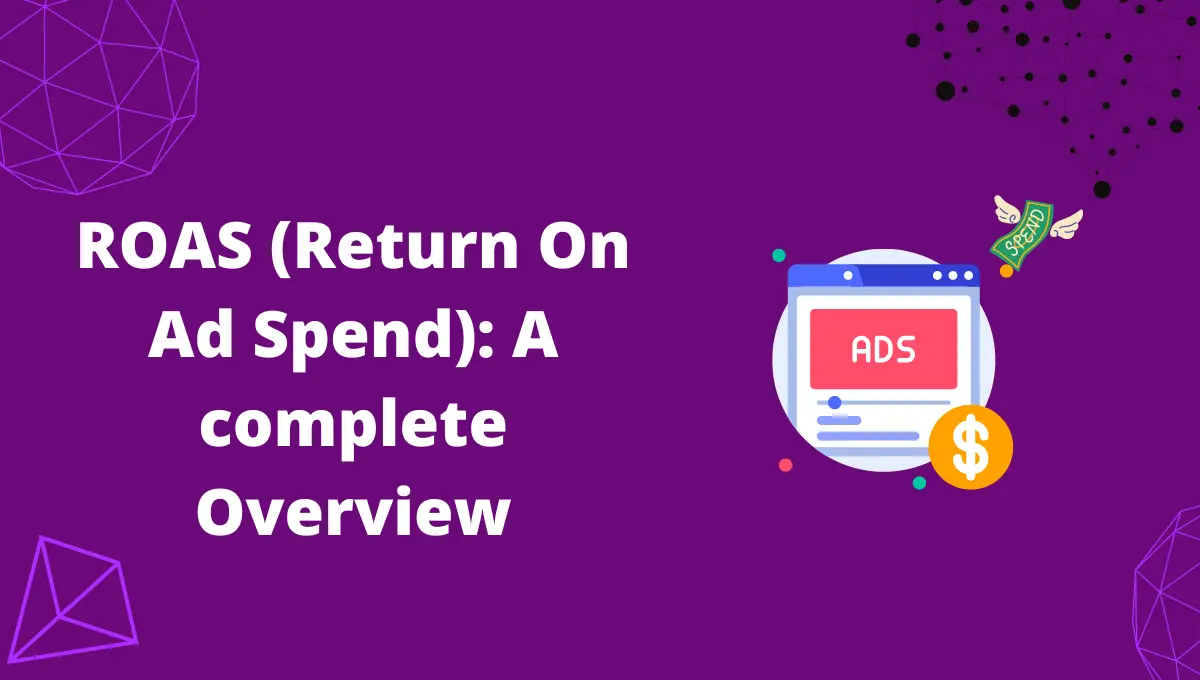No matter what the field of business is, people will always want to see the results of the work they have done. And it is no different for marketing.
For any type of marketing campaign, marketers want to see returns for the money and efforts they have spent on it. They constantly work on optimizing and improving metrics like quality score, CTR, CPA, etc.
Similar to the above metrics, ROAS (Return On Ad Spend) is another metric that can help you calculate the returns you get from an ad campaign. It is a very useful metric when you want to evaluate the performance of your campaigns and optimize them wherever necessary.
So, what is ROAS, and how do you use it to generate more revenue for your business? This article discusses all that you need to know about ROAS.
What Is ROAS?
Return On Ad Spend (ROAS) is one of the key performance indicators (KPIs) for determining the success of your campaigns. It refers to the amount of revenue earned compared to every single dollar you spent on a marketing campaign.
Using ROAS, you can measure and determine which marketing campaigns are performing better and which need improvements by measuring the revenue generated through each of them.
You can use ROAS to measure the revenue generated of an entire marketing strategy or use it to specifically measure the revenue of certain ads, targeting campaigns, etc.
In short, ROAS determines how effective your marketing campaigns are in attracting and engaging with your customers. The more conversions you get from your marketing campaigns, the more revenue you can earn from them.
That is, the more effective the campaigns are, the higher the ROAS. The higher the ROAS, the more you can grow your business.
How to Calculate ROAS?
You can calculate the ROAS of your marketing campaign using a simple formula.
ROAS = Revenue generated from ad campaign / Cost of ad campaign
Here’s an example of how you can calculate ROAS.
Let’s say you invested $500 on an advertising campaign, and the revenue you generated through it is $3000. Now, the ROAS of the advertising campaign would be
ROAS = $3000 / $500 = $6 or 6:1 (ROAS).
The above result means for every dollar you spent on your advertising campaign, you earned six dollars. This is a very good result.
While the calculation is very simple, collecting the required data may be difficult. For example, determining an ad’s cost is not so easy. You need to consider various factors to determine the amount you spend.
You need to determine whether you want to track only the amount spent on the campaign or if you want to add additional costs spent on it, such as vendor costs, team costs, and affiliate costs.
Vendor costs: This includes the fees and commissions you provide to vendors facilitating the ad campaign.
Team/salary costs: The amount spent on paying the in-house or agency personnel who help you manage the campaign.
Affiliate costs: This includes the commission given to affiliates who work individually or in a network.
To make things easier, you can calculate the ROAS based on the amount spent on ads alone and then calculate ROAS for additional costs later. This can give you a clear picture of how much returns you got from the campaigns.
Just ensure you use the accurate amount of money you spend on ads to calculate ROAS. This can give you an accurate ROAS on how much you earned from the ads.
Why Is ROAS Important?
ROAS is important for your business because it gives you an idea of how much you earn from the ad campaigns you run. It is an important KPI that shows how well your campaign is performing and how much it contributes to your business.
ROAS helps determine how much profit you get from a campaign and allows you to make improvements wherever necessary. You can make important marketing decisions based on the engagement and conversions you get from each campaign.
ROAS helps you measure, evaluate, and compare the performance of each marketing campaign and determines which one works best for your business’s growth.
By combining ROAS with CPC (cost-per-click), CPA (cost-per-acquisition), and CPL (cost-per-lead), you get a clear idea of the KPIs you need to hit to reach your revenue targets. You can also estimate the number of quality leads and conversions you get from each ad.
Through this, you can understand where to increase your ad spend (in case of higher ROAS) or decrease your ad spend (in case of lower ROAS). This can help improve the efficiency of your ad spend for future marketing campaigns.
Difference Between ROAS and ROI
Both ROI (return on investment) and ROAS determine the returns you generate from the money you invest. While ROI is a global metric that calculates the returns you get from the overall money spent on your organization, ROAS calculates the returns you get from the money you spent on advertising alone.
Advantages and Disadvantages of ROAS
ROAS is a very useful metric when it comes to managing your advertising costs. But it is not without its disadvantages. Let’s take a deeper look at the advantages and disadvantages of ROAS.
Advantages of ROAS
- No need for guesswork. By calculating ROAS, you get a clear picture of the returns you get from the money you spent on a particular ad. You can understand what works and what doesn’t and plan your future advertisements accordingly.
- Choose the best channel for your ads. Naturally, an ad doesn’t work best on all marketing channels. Through ROAS, you can learn which channels give you the highest returns for an ad campaign and focus more on it.
- Analysis made easy. Most businesses prefer ROAS to measure their ad’s success because it is easy to calculate and gives accurate results. You just need the data on the amount you spent and gained to calculate ROAS.
- Optimize your ads. By comparing the ROAS of two ad campaigns, you can understand what your audience prefers and optimize your ads accordingly.
Disadvantages/Limitations of ROAS
- ROAS gives you short-term results. ROAS is used to determine the performance of a specific ad campaign. It only shows how it is doing so far and not how it will do in the future. If you want the revenue you can generate in the long term, you must look into the customer’s Lifetime Value (LTV).
- The results aren’t concrete. ROAS only shows the returns you get from a particular number of customers. What if you run a low-cost campaign? Even if you have attracted only a small audience, it would show that your returns are high. So, you can’t really determine if you have succeeded in an ad campaign.
What Is a Good ROAS?
This is a question that has been on the minds of several marketers for a long time. The definite answer, however, is that there is no answer for it. A common benchmark that businesses follow while calculating ROAS is 4:1. That is, they should have a return of $4 for every dollar spent on an ad campaign.
A good ROAS differs depending on various factors, such as your advertising goals (awareness, acquisition, etc.) and the industry in which your brand is based. For example, brands that have a lower customer lifetime value will aim to get a higher ROAS.
So, it would be beneficial for you to set up a target ROAS based on your industry at the start of your ad campaigns. Target ROAS means you set a target return you expect to get for each dollar you spend on the campaign.
How to Improve ROAS?
As a business, your goal is to increase conversion rates and revenue for your brand. To improve your ROAS, you can lower your ad spend and optimize your campaigns to get maximum returns. Here are five tips you can use to increase your ROAS.
1. Set benchmarks
Understand what qualifies as a good ROAS for your business and set it as the benchmark for your campaigns. This can serve as a target ROAS you can aim for in your future campaigns.
2. Do split tests
A good ROAS will depend on a number of factors like the campaign goals, creatives, your industry, and the channel you use for marketing. It is better to conduct A/B split tests to see what gives the best results.
3. Lower your ad cost
One of the best ways to improve ROAS is to decrease the amount spent on ad campaigns. You can instead improve your quality score and increase your search results ranking and lower your CPC.
4. Optimize your landing pages
If your ads get more clicks but the conversion rate is low, it means there is a problem with your landing pages. Optimize your landing pages and make the customer journey as smooth as possible. Here are some things you can do to your landing pages.
Check if your landing page contents are clear and engaging.
Check if they are aligned with what the ad is about.
Check its loading speed.
See if you have given precise and clear CTA (Call To Action).
5. Understand your audience
Understand who your customers are and what value your products can add to their lives. An easy way to do this is to create buyer/user personas of your ideal customers.
This can help you understand your customer’s needs and create personalized ad campaigns for each user segment. You can generate more leads and drive more conversions without spending too much money on the ads. This can, in turn, improve your ROAS.
Conclusion
For any type of marketing campaign, its success is determined by the revenue it generates. ROAS is a very important key performance indicator that can give you accurate details on how much profit you are generating from your campaigns.
Make use of ROAS for your future campaigns and start generating more money than you spend on an ad campaign. It is one of the simplest and quickest ways to increase conversions and develop your business.
FAQ
ROAS (Return On Ad Spend) is one of the key performance indicators (KPIs) for determining the success of your campaigns. It refers to the amount of revenue earned compared to every single dollar you spend on a marketing campaign.
Using ROAS, you can measure and determine which marketing campaigns are performing better and which need improvements by measuring the revenue generated through each of them.
You can calculate the ROAS of your marketing campaign using a simple formula.
ROAS = Revenue generated from ad campaign / Cost of ad campaign
For example, let’s say you invested $500 on an advertising campaign, and the revenue you generated through it is $3000. Now, the ROAS of the advertising campaign would be performance marketing landing page ROAS = $3000 / $500 = $6 or 6:1 (ratio).
The above result means that for every dollar you spent on your advertising campaign, you earned six dollars. This is a very good result.
Both ROI (return on investment) and ROAS determine the returns you generate from the money you invest. While ROI is a global metric that calculates the returns you get from the overall money spent on your organization, ROAS calculates the returns you get from the money you spend on advertising alone.













